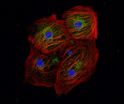Drifting herbicides produce uncertain effects
2014-02-10
(Press-News.org) Farmers should take extra precautions so drifting herbicides do not create unintended consequences on neighboring fields and farms, according to agricultural researchers.
The researchers found a range of effects -- positive, neutral and negative -- when they sprayed the herbicide dicamba on old fields -- ones that are no longer used for cultivation -- and on field edges, according to J. Franklin Egan, research ecologist, USDA-Agricultural Research Service. He said the effects should be similar for a related compound, 2,4-D.
"The general consensus is that the effects of the increased use of these herbicides are going to be variable," said Egan. "But, given that there is really so much uncertainty, we think that taking precautions to prevent herbicide drift is the right way to go."
Farmers are expected to use dicamba and 2,4-D on their fields more often in the near future because biotechnology companies are introducing crops genetically modified to resist those chemicals. From past experience, 2,4-D and dicamba are the herbicides most frequently involved in herbicide-drift accidents, according to the researchers.
Because the herbicides typically target broadleaf plants, such as wildflowers, they are not as harmful to grasses, Egan said. In the study, the researchers found grasses eventually dominated the field edge test site that was once a mix of broadleaf plants and grass. The old field site showed little response to the herbicide treatments.
Herbicide drift was also associated with the declines of three species of herbivores, including pea aphids, spotted alfalfa aphids and potato leaf hoppers, and an increase in a pest called clover root curculio, Egan said. The researchers found more crickets, which are considered beneficial because they eat weed seeds, in the field edge site.
The researchers, who report their findings in the current issue of Agriculture, Ecosystems and Environment, did not see a drop in the number of pollinators, such as bees, in the fields. However, the relatively small size of the research fields limited the researchers' ability to measure the effect on pollinators, according to Egan.
"That may be because pollinators are very mobile and the spatial scale of our experiment may not be big enough to show any effects," Egan said.
Farmers can cut down on herbicide drift by taking a few precautions, according to Egan. They can spray low-volatility herbicide blends, which are less likely to turn to vapors, and use a nozzle design on the sprayer that produces larger droplets that do not easily drift in the wind.
Egan also recommended that farmers follow application restrictions printed on herbicide labels and try to spray on less windy days when possible.
The tests were conducted on two farms in Pennsylvania. One field edge site was located near a forest and alfalfa field. The old field was an acre plot near Penn State's Russell E. Larson Agricultural Research farm.
Egan worked with Eric Bohnenblust, doctoral candidate in entomology; John Tooker, assistant professor of entomology and extension specialist, and David Mortensen, professor of weed and applied plant ecology, all of Penn State, and Sarah Goslee, U.S. Department of Agriculture ecologist.
INFORMATION:
The Environmental Protection Agency supported this work.
ELSE PRESS RELEASES FROM THIS DATE:
Young, unvaccinated adults account for severest flu cases
2014-02-10
DURHAM, N.C. – A snapshot of patients who required care at Duke University Hospital during this year's flu season shows that those who had not been vaccinated had severe cases and needed the most intensive treatment.
In an analysis of the first 55 patients treated for flu at the academic medical center from November 2013 through Jan. 8, 2014, Duke Medicine researchers found that only two of the 22 patients who required intensive care had been vaccinated prior to getting sick.
The findings were published online in Monday, Feb. 10, 2014, in the American Journal of Respiratory ...
Researchers discover immune signature that predicts poor outcome in influenza patients
2014-02-10
(Memphis, Tenn. – February 10, 2014) St. Jude Children's Research Hospital scientists have identified a signature immune response that might help doctors identify which newly diagnosed influenza patients are most likely to develop severe symptoms and suffer poor outcomes. The findings also help explain why infants and toddlers are at elevated risk for flu complications. The research appears in the upcoming issue of the American Journal of Respiratory and Critical Care Medicine.
The discovery came after investigators tracked flu infections for 28 days in 84 individuals ...
How do polar bears stay warm? Research finds an answer in their genes
2014-02-10
BUFFALO, N.Y. — In the winter, brown and black bears go into hibernation to conserve energy and keep warm.
But things are different for their Arctic relative, the polar bear. Within this high-latitude species, only pregnant females den up for the colder months.
So how do the rest survive the extreme Arctic winters?
New research points to one potential answer: genetic adaptations related to the production of nitric oxide, a compound that cells use to help convert nutrients from food into energy or heat.
In a new study, a team led by the University at Buffalo reports ...
Experimental care program keeps people with dementia at home longer, study shows
2014-02-10
An 18-month pilot program that brought resources and counselors to elderly Baltimore residents with dementia and other memory disorders significantly increased the length of time they lived successfully at home, according to Johns Hopkins researchers. Staying at home was a clear preference for most of those who participated in the study.
"The project demonstrated that we were able to help such people age in place without sacrificing their quality of life," says study leader Quincy Miles Samus, Ph.D., an assistant professor of psychiatry and behavioral sciences at the ...
Research reveals the give and take of urban temperature mitigating technologies
2014-02-10
TEMPE, Ariz. – Life in a warming world is going to require human ingenuity to adapt to the new realities of Earth. Greenhouse-gas induced warming and megapolitan expansion are both significant drivers of our warming planet. Researchers are now assessing adaptation technologies that could help us acclimate to these changing realities.
But how well these adaptation technologies – such as cool roofs, green roofs and hybrids of the two – perform year round and how this performance varies with place remains uncertain.
Now a team of researchers, led by Matei Georgescu, ...
The genetic origins of high-altitude adaptations in Tibetans
2014-02-10
Genetic adaptations for life at high elevations found in residents of the Tibetan plateau likely originated around 30,000 years ago in peoples related to contemporary Sherpa. These genes were passed on to more recent migrants from lower elevations via population mixing, and then amplified by natural selection in the modern Tibetan gene pool, according to a new study by scientists from the University of Chicago and Case Western Reserve University, published in Nature Communications on Feb. 10.
The transfer of beneficial mutations between human populations and selective ...
Study involving twin sisters provides clues for battling aggressive cancers
2014-02-10
CINCINNATI – Analyzing the genomes of twin 3-year-old sisters – one healthy and one with aggressive leukemia – led an international team of researchers to identify a novel molecular target that could become a way to treat recurring and deadly malignancies.
Scientists in China and the United States report their findings online Feb. 9 in Nature Genetics. The study points to a molecular pathway involving a gene called SETD2, which can mutate in blood cells during a critical step as DNA is being transcribed and replicated.
The findings stem from the uniquely rare opportunity ...
Genome editing goes hi-fi
2014-02-10
SAN FRANCISCO, CA—February 9, 2014—Sometimes biology is cruel. Sometimes simply a one-letter change in the human genetic code is the difference between health and a deadly disease. But even though doctors and scientists have long studied disorders caused by these tiny changes, replicating them to study in human stem cells has proven challenging. But now, scientists at the Gladstone Institutes have found a way to efficiently edit the human genome one letter at a time—not only boosting researchers' ability to model human disease, but also paving the way for therapies that ...
Cochlear implants -- with no exterior hardware
2014-02-10
Cochlear implants — medical devices that electrically stimulate the auditory nerve — have granted at least limited hearing to hundreds of thousands of people worldwide who otherwise would be totally deaf. Existing versions of the device, however, require that a disk-shaped transmitter about an inch in diameter be affixed to the skull, with a wire snaking down to a joint microphone and power source that looks like an oversized hearing aid around the patient's ear.
Researchers at MIT's Microsystems Technology Laboratory (MTL), together with physicians from Harvard Medical ...
Scientists invent advanced approach to identify new drug candidates from genome sequence
2014-02-10
JUPITER, FL—February 9, 2014—In research that could ultimately lead to many new medicines, scientists from the Florida campus of The Scripps Research Institute (TSRI) have developed a potentially general approach to design drugs from genome sequence. As a proof of principle, they identified a highly potent compound that causes cancer cells to attack themselves and die.
"This is the first time therapeutic small molecules have been rationally designed from only an RNA sequence—something many doubted could be done," said Matthew Disney, PhD, an associate professor at TSRI ...







